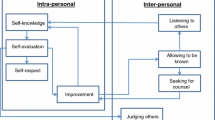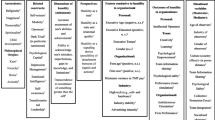Abstract
The virtue of humility is often considered to be at odds with common business practice. In recent years, however, scholars within business ethics and leadership have shown an increasing interest in humility. Despite such attention, the argument for the relevance of humility in business could be expanded. Unlike extant research that focuses on humility as a character-building virtue or instrumentally useful leadership trait, this article argues that humility reflects the interdependent nature of business. Through such an approach, the article gives an extrinsic motivation of the relevance of humility in business, and, from a theoretical point of view, links the intra-personal and intra-organizational perspective on humility to an inter-organizational one. The article contextualizes the virtue of humility by relating it to the economic, cognitive, and moral aspects of business practice and managerial work. It claims that the assumption of self-sufficiency in business is a grave misrepresentation of what business is—a practice characterized by interdependency. Potential links between virtue ethics, leadership, and contextually oriented theories of business, such as stakeholder theory, network theories, and resource dependence theory, are also identified.
Similar content being viewed by others
References
Aquinas, T. (1955–1957). Summa Contra Gentiles, Book IV (C. J. O’Neil, Trans.). New York: Hanover House. Retrieved July 3, 2014, from http://dhspriory.org/thomas/ContraGentiles.htm.
Argandoña, A. (2003). Fostering values in organizations. Journal of Business Ethics, 45(1), 15–28.
Argandoña, A. (2012). Corporate social responsibility in the encyclical Caritas in Veritate. In M. Schlag & J. A. Mercado (Eds.), Free markets and the culture of common good (pp. 177–189). Dordrecht: Springer.
Argandoña, A. (2013). Reputation and humility in corporate management. Working Paper WP-1071-E. IESE Business School, University of Navarra.
Benedict XVI. (2009). Caritas in Veritate. Vatican: Holy See.
Cameron, K. S., Dutton, J. E., & Quinn, R. E. (Eds.). (2003). Positive organizational scholarship. San Francisco: Berrett-Koehler.
Chan, C. C. A., McBey, K., & Scott-Ladd, B. (2011). Ethical leadership in modern employment relationships: Lessons from St. Benedict. Journal of Business Ethics, 100(2), 221–228.
Collins, J. (2001). Level 5 Leadership: The triumph of humility and fierce resolve. Harvard Business Review, 79(1), 66–76.
Dawson, D. (2009). Conflicting stories of virtue in UK healthcare: Bringing together organisational studies and ethics. Business Ethics: A European Review, 18(2), 95–109.
De Bruin, B. (2013). Epistemic virtues in business. Journal of Business Ethics, 113(4), 583–595.
Donaldson, T., & Preston, L. E. (1995). The stakeholder theory of the corporation: Concepts, evidence, and implications. Academy of Management Review, 20(1), 65–91.
Drees, J. M., & Heugens, P. P. M. A. R. (2013). Synthesizing and extending resource dependence theory: A meta-analysis. Journal of Management, 39(6), 1666–1698.
Freeman, R. E. (1984). Strategic management: A stakeholder approach. Marshfield: Pitman.
Frostenson, M. (2009). Stakeholder theory and the ‘black box problem’: Internal clarity or confusion? Philosophy of Management, 8(3), 37–46.
Frostenson, M., & Prenkert, F. (2014). Sustainable supply chain management when focal firms are complex: A network perspective. Journal of Cleaner Production. doi:10.1016/j.clepro.2014.05.034.
Grenberg, J. (2005). Kant and the ethics of humility: A story of dependence, corruption and virtue. Cambridge: Cambridge University Press.
Hillman, A. J., Withers, M. C., & Collins, B. J. (2009). Resource dependence theory: A review. Journal of Management, 35(6), 1404–1427.
Hume, D. (1751). An enquiry concerning the principles of morals. Retrieved July 3, 2014, from http://www.gutenberg.org/files/4320/4320-h/4320-h.htm.
Jacobs, D. C. (2004). A pragmatist approach to integrity in business ethics. Journal of Management Inquiry, 13(3), 215–223.
Kallasvuo, O. P. (2007). Humility. Harvard Business Review, 85(1), 16.
Kopelman, S., & Rosette, A. S. (2008). Cultural variation in response to strategic emotions in negotiations. Group Decision and Negotiation, 17(1), 65–77.
Livaccari, C. (2014). Just who was Confucius, anyway? Asia Society. Retrieved June 26, 2014, from http://asiasociety.org/education/chinese-language-initiatives/just-who-was-confucius-anyway.
MacIntyre, A. (1999). Dependent rational animals: Why human beings need the virtues. London: Duckworth.
Miles, L. (2006). The application of Anglo-American corporate practices in societies influenced by Confucian values. Business and Society Review, 111(3), 305–321.
Molyneaux, D. (2003). “Blessed are the meek, for they shall inherit the Earth”: An aspiration applicable to business? Journal of Business Ethics, 48(4), 347–363.
Morris, J. A., Brotheridge, C. M., & Urbanski, J. C. (2005). Bringing humility to leadership: Antecedents and consequences of leader humility. Human Relations, 58(10), 1323–1350.
Nielsen, R., Marrone, J. A., & Ferraro, H. S. (2014). Leading with humility. New York: Routledge.
Nielsen, R., Marrone, J. A., & Slay, H. S. (2010). A new look at humility: Exploring the humility concept and its role in socialized charismatic leadership. Journal of Leadership & Organizational Studies, 17(1), 33–43.
Nohria, N., & Eccles, R. G. (Eds.). (1992). Networks and organizations: Structure, form, and action. Boston: Harvard Business School Press.
Ou, A. Y., Tsui, A. S., Kinicki, A. J., Waldman, D. A., Xiao, Z., & Song, L. J. (2014). Humble chief executive officers’ connections to top management team integration and middle managers’ responses. Administrative Science Quarterly, 59(1), 34–72.
Owens, B. P., & Hekman, D. R. (2012). Modeling how to grow: An inductive examination of humble leader behaviors, contingencies, and outcomes. Academy of Management Journal, 55(4), 787–818.
Owens, B. P., Johnson, M. D., & Mitchell, T. R. (2013). Expressed humility in organizations: Implications for performance, teams, and leadership. Organization Science, 24(5), 1517–1538.
Peterson, C., & Seligman, M. E. P. (2004). Character strengths and virtues: A classification and handbook. New York: Oxford University Press.
Pfeffer, J., & Salancik, G. R. (1978). The external control of organizations: A resource dependence perspective. New York: Harper and Row.
Rhenman, E. (1964). Företagsdemokrati och företagsorganisation. Stockholm: P.A. Norstedts & Söners.
Rowley, T. (1997). Moving beyond dyadic ties: A network theory of stakeholder influences. Academy of Management Review, 22(4), 887–910.
Rozuel, C., & Kakabadse, N. (2010). Ethics, spirituality and self: Managerial perspective and leadership implications. Business Ethics: A European Review, 19(4), 423–436.
Snow, N. E. (1995). Humility. The Journal of Value Inquiry, 29(2), 203–216.
Solomon, R. C. (1992). Ethics and excellence. Oxford: Oxford University Press.
Solomon, R. C. (1999). A better way to think about business: How personal integrity leads to corporate success. Oxford: Oxford University Press.
Spiegel, J. S. (2003). The moral irony of humility. Logos: A Journal of Catholic Thought and Culture, 6(1), 131–150.
Suchman, M. C. (1995). Managing legitimacy: Strategic and institutional approaches. Academy of Management Review, 20(3), 571–610.
Tengblad, S. (2002). Time and space in managerial work. Scandinavian Journal of Management, 18(4), 543–566.
van Kleef, G. A. (2014). Understanding the positive and negative effects of emotional expressions in organizations: EASI does it. Human Relations, 67(9), 1145–1164.
Vera, D., & Rodriguez-Lopez, A. (2004). Humility as a source of competitive advantage. Organizational Dynamics, 33(4), 393–408.
Waley, A. (1938). The analects of Confucius. New York: Macmillan Company.
Weiss, H. W., & Knight, P. A. (1980). The utility of humility: Self-esteem, information search and problem-solving efficiency. Organizational Behavior and Human Performance, 25(2), 216–223.
Author information
Authors and Affiliations
Corresponding author
Rights and permissions
About this article
Cite this article
Frostenson, M. Humility in Business: A Contextual Approach. J Bus Ethics 138, 91–102 (2016). https://doi.org/10.1007/s10551-015-2601-9
Received:
Accepted:
Published:
Issue Date:
DOI: https://doi.org/10.1007/s10551-015-2601-9




